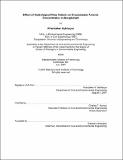Effect of hydrological flow pattern on groundwater arsenic concentration in Bangladesh by Khandaker Ashfaque.
Author(s)
Ashfaque, Khandaker
DownloadFull printable version (41.95Mb)
Other Contributors
Massachusetts Institute of Technology. Dept. of Civil and Environmental Engineering.
Advisor
Charles F. Harvey.
Terms of use
Metadata
Show full item recordAbstract
Widespread arsenic contamination of groundwater has become a major concern in Bangladesh since the water supply, particularly in rural areas, is heavily dependent on groundwater. However, relative to the extent of research on biogeochemical processes of arsenic mobilization, very little work has been conducted to understand the complex transient dynamics of groundwater flow, and the transport of arsenic and other solutes that control its mobility in the area. A detailed three-dimensional hydrological model of our study area in Munshiganj indicates that: (1) the shallow aquifer acts primarily as a conduit for flow from ponds and rice fields to irrigation wells and rivers; (2) most inflow to the aquifer occurs during the dry season, and monsoon contributes relatively little to the inflow since the aquifer storage is small; (3) since the increase in irrigation pumping and pond construction have changed the groundwater flow dynamics, arsenic concentrations are unlikely to be at steady-state. These observations are consistent with those from the lumped-parameter model. Analysis of various fluxes from the three-dimensional groundwater model also reveals that ponds provide the largest source of recharge to the aquifer, and hence, is a potential source of dissolved arsenic to the subsurface. Accordingly, a "Pond Hypothesis" has been developed suggesting that arsenic mobilization in Bangladesh aquifer is deriving from reductive dissolution of various arsenic bearing oxides (the widely accepted mechanism for arsenic mobilization in Bangladesh) deposited at the pond bottoms. The process of reductive dissolution occurs in the presence of organic matter and under reducing environment, when residing microbes respire on oxygen from oxide-minerals (e.g. Fe and Mn oxides) to process the organic matter for growth, and subsequently causes release of arsenic associated with the oxide-minerals to the aqueous phase. (cont.) Afterwards, at the end of flooding season, the dissolved arsenic along with mixture of various dissolved solutes from pond bottoms enters the aquifer and is driven towards the well screen both vertically due to overlying recharge and horizontally due to increased pumping. Extensive small-scale pump tests and one large-scale extended pumping experiment carried out at our study area in Munshiganj indicates that the aquifer is anisotropic in nature creating flow convergence at the depth of irrigation well screen. Results from a three-dimensional hydrological model suggests that groundwater irrigation has changed the flow dynamics in the area - not only by reducing the residence and travel times, but also carrying solutes to particular depth from different sources and locations. Model simulations carried out for three different scenarios - 'Current Stage' (if the current flow condition continues), 'Ancient Stage' (before the advent of habitation and irrigation practices), and 'Inception Stage' (the beginning of irrigation and creation of ponds) - indicates that in general, the rice field water dominates at the shallowest depth while pond water dominates at the depth of irrigation well, and the contribution from river water increases with depth. Analysis of the average groundwater age distribution indicates that younger age dominates at shallower depths. More importantly, the age values at the monitoring locations can be explained by the relative contribution of recharge water from different sources. Furthermore, modeling results indicate that the groundwater age at 30m depth in Bejgoan Field Site is about 24-60 years old, which is consistent with the tritium age measurement at the same depth. The stable water isotope values in our study area shows a similar profile to the dissolved arsenic concentration, and their peak concentrations coincidence with the depth of irrigation well. (cont.) Furthermore, comparison of calculated and measured isotopic values at the Bejgoan Field Site indicates that the calculated values are within the range of measured values, and thereby, confers that the observed isotopic profile results from the mixing of water from various recharge sources. More importantly, the lighter water at the depth of peak arsenic concentration can only be derived from lighter pond water recharge in November, whereas recharge from river and rainfall mainly occurs after March when those waters are actually heavier. Finally, observation of two distinct peaks in the dissolved arsenic concentration profile from a recently installed cluster beside a highly recharging pond provides a direct evidence supporting the "Pond Hypothesis". While the peak concentration at 30-40m depth corresponds to the characteristic regional hump observed in our study area, the second peak at a shallower depth (20m) has been explained as the local arsenic plume originating from the nearby pond bottom.
Description
Thesis (Ph. D.)--Massachusetts Institute of Technology, Dept. of Civil and Environmental Engineering, 2007. Includes bibliographical references.
Date issued
2007Department
Massachusetts Institute of Technology. Department of Civil and Environmental EngineeringPublisher
Massachusetts Institute of Technology
Keywords
Civil and Environmental Engineering.